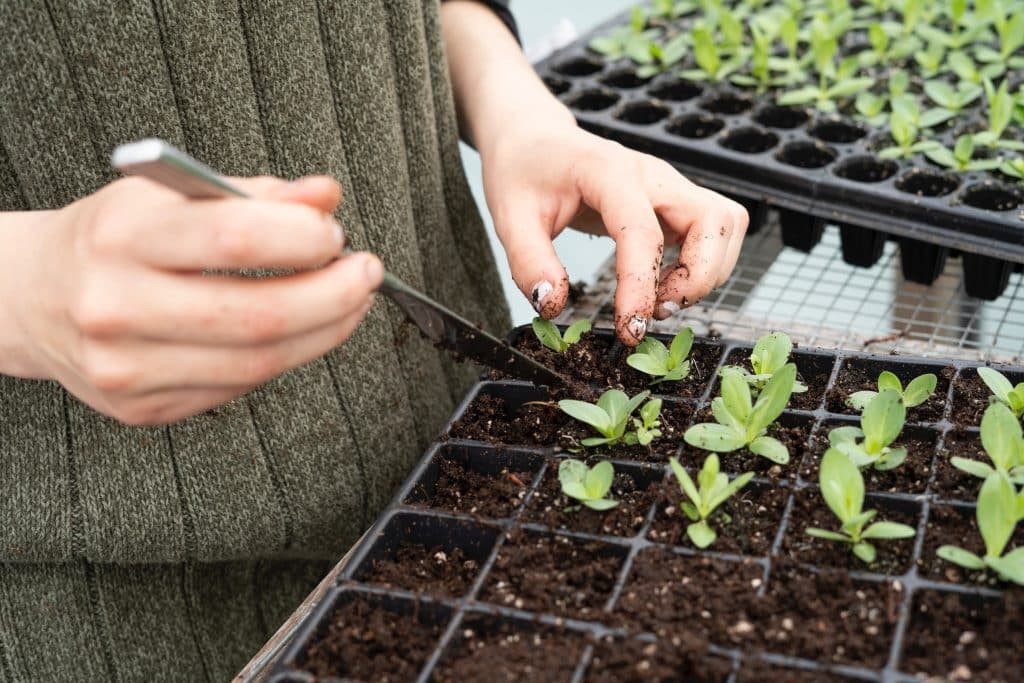Are you worried there may be a male plant in your marijuana crop? Or have you just started a crop using non-feminized seeds and you’re starting to become suspicious of a sneaky male plant ruining your entire crop? Either way, Best Bud Seeds can help you decipher between a male, female, and hermaphrodite plant and how to utilize a male plant if you have one.
Transplanting Marijuana Table of Contents:
- Why Transplant Marijuana Plants
- Removing Marijuana Plants from Original Pot
- Handling Your Marijuana Plants
- Size and Space of New Pots
- When To Transplant Your Marijuana Plants

Why Transplant Marijuana Plants
Transplanting gives a marijuana plant’s root system more space to spread out, allowing the plant to grow healthy and strong, ultimately resulting in better quality bud and higher yields. And who doesn’t want that?
The main purpose for transplanting is when roots become cramped and can’t spread out they can get tangled and become “rootbound”—this will effective choke the plant, leading to a stunted and sick plant.
Removing Marijuana Plants from Original Pot
All young cannabis plants should start in a 4-inch or 1-gallon pot. This starting pot should be adequate for a few weeks before transplanting is needed, so ideally around the beginning of the vegetative state. Best Bud Seeds recommends that the first transplanting should occur after the seedling has sprouted its 4th or 5th set of leaves. Below is a step by step guide on how to remove your plants from its first pot, and eventually transplant them to a larger container:
Wash your hands and/or wear gloves to prevent contamination of the delicate roots and keep the surroundings as sanitary as possible.
- Give the plant a light sprinkling of water to help minimize shock; don’t drench it, as the soil will be difficult to work with.
- Fill the receiving pot with soil, allowing enough space for the new plant.
- Avoid overpacking the soil during and after transplanting—this can compromise drainage and damage the root system.
- Do not disturb or damage the roots when transplanting; the first transplanting poses the greatest risk for shock, which can occur from root damage and agitation.
- Avoid intense light when transplanting; this will help prevent transplant shock as well.
- Fully water in the plant once it’s in its new home.
Additional transplanting of cannabis plants is also a possibility in the future, and here’s why. You may need to transplant your weed plant a second or third time to maximize its growing potential. And as always, please monitor plants for symptoms of stress or overcrowded roots. To do so, follow the steps above, and make sure your new container is at least twice to three times the size as the beginning container.
The finishing container is the final home of a plant until it’s harvested. This will be the largest container for a plant, and you always want to transplant into this pot 1-2 weeks before the flowering stage—you don’t want to disturb a plant while it’s flowering at all (for obvious reasons).
Handling Your Marijuana Plants
So what is the worst that could happen if you make a mistake while transplanting your cannabis plants? Your plants could go into shock, which might cause their leaves to turn yellow and then wither, finally dying and dropping off the plant altogether.
Yikes. We’re not trying to do that.
While risky, transplanting your plants will have an overwhelmingly positive effect (when done responsibly). It will help speed up the maturing process of the plant while simultaneously requiring even less hands-on care from you as the grower. In summary, it’s well worth the risk and hassle in the end, even if it seems mentally taxing in the beginning.
Size and Space of New Pots
Your marijuana plant’s container will determine how much the roots can stretch out, and therefore how big your plant will get. A pot that’s too small will stunt its growth. While there’s nothing totally wrong with it, you don’t want to plant a seed in a giant pot because you could potentially waste soil if the seed doesn’t make it (if you believe you could waste soil). Also, if growing cannabis outdoors, it’s hard to plan out a garden and where to put your seeds in the ground if some seeds don’t make it. For the seeds that do make it, they will need bigger homes after several weeks of growing and will need to be transplanted either into a bigger pot or directly into the ground. Reminder: When planting into the ground, make sure not to crowd your plants so their roots don’t run into each other.
So, unfortunately because size is a major issue in transplanting marijuana plants, rootbound can occur in plants that have crowded roots.
The symptoms of a rootbound plant include:
- Flimsy new growth
- Stunted flower production
- Stem discoloration (reddening)
- Nutrient sensitivity
- Nutrient deficiency
A rootbound plant may also appear under-watered. If a plant requires watering more than once a day, it may need to get transplanted.

When To Transplant Your Marijuana Plants
There isn’t a precise time on the clock or calendar telling you to transplant, but it is crucial to transplant between an optimal range of time for best results. Best Bud Seeds recommends that you do it when your plants’ roots have reached as far as they can grow within the constraints of their container. Roots are more likely to grow further and faster when they are enclosed in a container; it’s almost as if they are eager to reach open space as soon as possible.
Our rule of thumb is that once your cannabis plants have sprouted, two leaves that are oblong in shape will start to be visible. These are called cotyledons and they come out from the one tiny stem that will pop up from the soil. They don’t look like typical cannabis leaves, but after just a few days they will drop off and normal marijuana leaves will emerge. This shows you that your plants are beginning their seedling phase of life. Plants in this phase are still small, but their roots will begin to grow and develop into a full root system – although it may look impressive, it’s still incredibly fragile and must be handled with a light hand.
So, when is it too early to transplant your marijuana plants? You can’t move your plants while they are in their seedling phase just yet, but it is good to ensure that they have plenty of light and water (or just moisture in the soil). The seedling phase can usually last between two and six weeks long. Doing it too early would be devastating for your tender seedlings, so handling them with caution is necessary. You can test the firmness of the stem by grabbing it with your hand gently, without doing any damage to it, to see if it’s ready to be transplanted.
Have you started a grow using Best Bud Seeds?

Tag Us In Your Grow On IG! @BestBudSeeds
